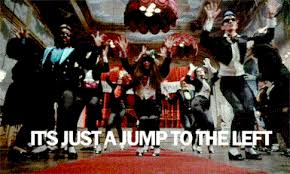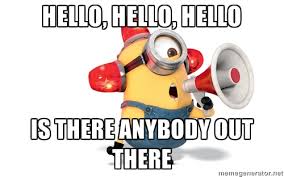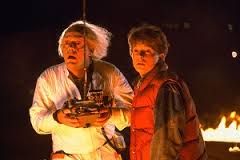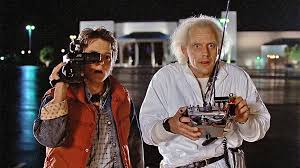 I’m so honored to be hosting the April 2016 Nonprofit Blog Carnival. When announcing April’s carnival theme in my April 4th Call for Submissions post, I was excited to see how the non-profit blogosphere would respond to this question: “If you could go back in time and give your younger-fundraising-self one piece of advice, what would it be?”
I’m so honored to be hosting the April 2016 Nonprofit Blog Carnival. When announcing April’s carnival theme in my April 4th Call for Submissions post, I was excited to see how the non-profit blogosphere would respond to this question: “If you could go back in time and give your younger-fundraising-self one piece of advice, what would it be?”
I have made many mistakes over the last 20+ years of fundraising and non-profit management, and I love to share those teachable moments with younger professionals. However, the idea of learning from some of our sector’s greatest non-profit thinkers was fun and thrilling.
I challenged my fellow bloggers to incorporate time travel movie references into their posts. Having read all of the submissions, I think you won’t be disappointed. Not only did bloggers serve up some amazing advice, but in some cases bloggers included fun references to movies such as Back to the Future, Groundhog Day, The Rocky Horror Picture Show, Howard the Duck, and much more.
I hope you enjoy this month’s virtual carnival rides and the sweet and savory posts chock-full of advice and tips!
 Joe Garecht at The Fundraising Authority blog reached out to some of the non-profit sector’s best consultants, speakers and authors and asked them to answer this month’s carnival question in his post If Famous Fundraisers Had to Start All Over Again… What They Wish they Had Known… Very entrepreneurial, Joe! 😉
Joe Garecht at The Fundraising Authority blog reached out to some of the non-profit sector’s best consultants, speakers and authors and asked them to answer this month’s carnival question in his post If Famous Fundraisers Had to Start All Over Again… What They Wish they Had Known… Very entrepreneurial, Joe! 😉
I am never disappointed by what Jeff Brooks writes over at Future Fundraising Now, which is why I was so honored when he wrote something for this month’s carnival. As a young fundraiser, Jeff was prone to extreme fundraising approaches. If he could go back and advise himself, he’d tell that young extremist that moderation is a lot smarter. (Note: I think Jeff is being too hard on himself when he refers to his present-day-self as “a gray-haired, middle-aged codger.”) Click here to read his non-codger advice.
“It’s about sticking with what you know is right,” explains Claire Axelrad in her Clairification post titled The Meaning of Philanthropy, Not Fundraising – Part 1. And she always knew that she couldn’t take sole credit for money that was raised under her watch. But she wishes she had known how important it is to actively give others credit. While her younger-self understood this to a degree, she didn’t to the extent that she does today. It’s so important in fundraising to come from a place of love. Because, in essence, that’s what philanthropy means.
I had no idea that Ignited Fundraising blog’s Lori Jacobwith had worked on a U.S. Senate campaign back in the 1980s. In her post Don’t Make My Fundraising Mistakes, Make New Ones, she would tell her younger-fundraising-self that if she’s counting on people, especially volunteers (and anyone who is NOT a fundraising professional is a volunteer!) to support her work in ANY way. . . she needs to treat them like her favorite and most special donors or customers.
 I love the fact that Bill Murray makes a cameo appearance in this month’s Nonprofit Blog Carnival thanks to Empower Nonprofits‘ Jeremy Koch. Jeremy will tell you everything Bill Murray taught him about how to free yourself from the fundraising time loop and improve your fundraising. Keep Calm and Chive On, Jeremy!
I love the fact that Bill Murray makes a cameo appearance in this month’s Nonprofit Blog Carnival thanks to Empower Nonprofits‘ Jeremy Koch. Jeremy will tell you everything Bill Murray taught him about how to free yourself from the fundraising time loop and improve your fundraising. Keep Calm and Chive On, Jeremy!
My longtime and dear friend, Dani Robbins over at Non Profit Evolution, went into overdrive this month and submitted two posts with tons of advice. In her first submission, she shares EIGHT Teachable Moments that she wishes someone had given her when she was younger. She adds another 23 things she learned along the way in her post Reflecting on my Pursuit of Social Justice. Simply amazing . . . Thanks for sharing, Dani!
Mary Cahalane at Hands On Fundraising blog won me over by referencing one of my favorite movies — Working Girl — as she talked about her fundraising career path. She wonders how things might have been different “if only . . .” While everyone will benefit from reading To my younger fundraising self – and maybe you, new fundraising professionals are simply going to LOVE this post!!!
Seth Rosen’s post over at Joan Garry Consulting‘s blog complements the previous submission regarding the keys to building a fundraising career for those just starting out in the field. If you are new to fundraising, you’ll want to read Fundraising Career Advice: What I Wish I Knew Then.
In Zach Hagopian’s first fundraising event that he hosted with his co-founder in 2014, they learned a valuable lesson: “To leave limitations behind and think bigger / outside the box.” Event coordinators won’t want to miss out on reading Accelevents’ Back to the (Fundraising) Future.
Of all the non-profit consultants I know, Pamela Grow has an inspirational journey line stories to share. I simply love how she tells the story about what happened when the board hired a new executive director for her organization. I won’t give away the surprise, but I guarantee you will love the advice she dispenses to her younger-self!
- Advice to my younger-fundraising-self about email usage
- Advice to my younger-fundraising-self about delegation and collaboration
- Advice to my younger-fundraising-self about about direct mail
- Advice to my younger-fundraising-self about event management
- Advice to my younger-fundraising-self about phone-a-thons
Craig Linton at Fundraising Detective blog will host the May 2016 Nonprofit Blog Carnival. The theme will be “Leadership in Fundraising: the best or worst boss you ever had. What did you learn? How was the experience? Tips for others.” Click here for more details and how to submit your blog entry for consideration.
As I say at the end of all my blog posts . . .
Here’s to your health! (and try not to eat too much cotton candy at this month’s carnival)
Erik Anderson
Founder & President, The Healthy Non-Profit LLC
www.thehealthynonprofit.com
erik@thehealthynonprofit.com
http://twitter.com/#!/eanderson847
http://www.facebook.com/eanderson847
http://www.linkedin.com/in/erikanderson847

 This month DonorDreams is hosting the nationally acclaimed
This month DonorDreams is hosting the nationally acclaimed  As many readers know, I was once an executive director for a non-profit organization that ran a Duck Race fundraiser. For those of you who don’t know what a Duck Race is, it is simply a raffle where serial numbers on the bottom of little rubber ducks correspond to numbered adoption papers sold to donors. The first 10 ducks that cross a water raceway finish line win prizes. The challenge from a revenue perspective is essentially two-fold:
As many readers know, I was once an executive director for a non-profit organization that ran a Duck Race fundraiser. For those of you who don’t know what a Duck Race is, it is simply a raffle where serial numbers on the bottom of little rubber ducks correspond to numbered adoption papers sold to donors. The first 10 ducks that cross a water raceway finish line win prizes. The challenge from a revenue perspective is essentially two-fold: In the 1986 box office flop
In the 1986 box office flop  As a teenager, I was a
As a teenager, I was a  Instead of picking up the phone and talking to mail professionals, that 31-year-old executive director decided to engage a few friends and do a 12,000 piece mailer by himself. Uh-huh. I thought it would be easy to:
Instead of picking up the phone and talking to mail professionals, that 31-year-old executive director decided to engage a few friends and do a 12,000 piece mailer by himself. Uh-huh. I thought it would be easy to: As a young Boy Scout professional in the 1990s, I was just starting to learn may way around fundraising principles and best practices. While I previously had helped out with a few special events and written a grant proposal for another organization, I never helped plan-organize-implement an annual campaign pledge drive, which is what I was being asked to do with a group of Friends of Scouting (FOS) volunteer within my district.
As a young Boy Scout professional in the 1990s, I was just starting to learn may way around fundraising principles and best practices. While I previously had helped out with a few special events and written a grant proposal for another organization, I never helped plan-organize-implement an annual campaign pledge drive, which is what I was being asked to do with a group of Friends of Scouting (FOS) volunteer within my district. Fast forward a number of years into the future when I was a first-time executive director for a Boys & Girls Club.
Fast forward a number of years into the future when I was a first-time executive director for a Boys & Girls Club. Sometimes when I daydream, I see myself standing outside my house in the street with Dr. Emmitt Brown (aka Christopher Lloyd’s character in Back to the Future), waiting for the lighting storm so I can jump into that
Sometimes when I daydream, I see myself standing outside my house in the street with Dr. Emmitt Brown (aka Christopher Lloyd’s character in Back to the Future), waiting for the lighting storm so I can jump into that  Ahhhh, yes. I remember this embarrassing lesson very well. It occurred in the late 1990s when I was a young Boy Scout professional who was responsible for membership management, district-wide programming, local unit support and fundraising for a small suburban district in the Northwest Chicago suburbs. It was the 20th Century and the idea of email was new and evolving as a way to communicate with non-profit volunteers.
Ahhhh, yes. I remember this embarrassing lesson very well. It occurred in the late 1990s when I was a young Boy Scout professional who was responsible for membership management, district-wide programming, local unit support and fundraising for a small suburban district in the Northwest Chicago suburbs. It was the 20th Century and the idea of email was new and evolving as a way to communicate with non-profit volunteers. To better understand what I just said, I will use a simple analogy . . .
To better understand what I just said, I will use a simple analogy . . . Sometimes, when I’m daydreaming, I imagine myself in a time machine going back to 1999 to have a serious conversation about email usage with my younger-fundraising-self. I also sometimes wonder if it would be helpful to take a page out of the Arnold Shwarzenegger Terminator movies by traveling back in time to sabotage the work of the person who created email. 😉
Sometimes, when I’m daydreaming, I imagine myself in a time machine going back to 1999 to have a serious conversation about email usage with my younger-fundraising-self. I also sometimes wonder if it would be helpful to take a page out of the Arnold Shwarzenegger Terminator movies by traveling back in time to sabotage the work of the person who created email. 😉 A few months ago I was onsite with a client and found myself working with a young fundraising professional. They hadn’t been on the job for long. In fact, their background wasn’t even in resource development. If my memory serves me well, then I think they had a college degree and an internship’s worth of experience in marketing or public relations.
A few months ago I was onsite with a client and found myself working with a young fundraising professional. They hadn’t been on the job for long. In fact, their background wasn’t even in resource development. If my memory serves me well, then I think they had a college degree and an internship’s worth of experience in marketing or public relations. Later that evening, I was working from the hotel room with the television chirping away in the background. One of the “Back to the Future” movies was the evening feature. Ignoring Michael J. Fox and focusing instead on my work from earlier in the day, I started thinking about all of the fundraising mistakes I had made (and hopefully learned from) when I was younger.
Later that evening, I was working from the hotel room with the television chirping away in the background. One of the “Back to the Future” movies was the evening feature. Ignoring Michael J. Fox and focusing instead on my work from earlier in the day, I started thinking about all of the fundraising mistakes I had made (and hopefully learned from) when I was younger. Let’s have a little fun with this topic. It lends itself nicely to it. Right? 😉
Let’s have a little fun with this topic. It lends itself nicely to it. Right? 😉 You are welcome to write your blog post anytime during the month of May (or even submit a post you may have previously published); however, I must receive your submission by the end of the day on Monday, April 25, 2016:
You are welcome to write your blog post anytime during the month of May (or even submit a post you may have previously published); however, I must receive your submission by the end of the day on Monday, April 25, 2016:

